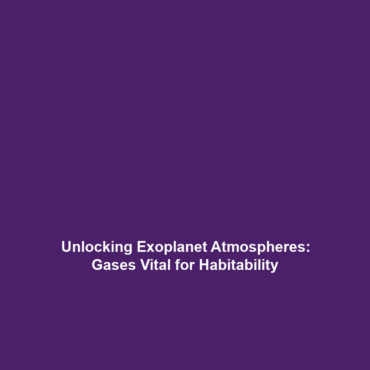Super-Earths: The Enigmatic Exoplanets in Habitability Research
Super-Earths are a captivating category of exoplanets that are larger than Earth but smaller than Neptune, often situated in habitable zones where conditions may allow for liquid water to exist. These planets hold significant promise in the quest for extraterrestrial life and understanding planetary systems beyond our own. Their unique characteristics challenge our traditional concepts of planet formation and habitability, making them a focal point for current astronomical research.
Key Concepts of Super-Earths
Super-Earths bridge the gap between terrestrial planets like Earth and gas giants like Neptune. Here are some key concepts associated with these exoplanets:
- Definition and Size: Super-Earths range from about 1.25 to 2 times the size of Earth, falling within a size category that suggests they may possess substantial atmospheres.
- Habitable Zones: Many Super-Earths are located in the habitable zone of their stars, where surface conditions could permit the presence of liquid water, a crucial ingredient for life.
- Types of Super-Earths: These planets can be rocky, like Earth, or have thicker atmospheres similar to those found on gas giants.
- Potential for Life: The search for life often targets Super-Earths due to their size and position, making them prime candidates for further study.
Applications and Real-World Uses
The study of Super-Earths significantly contributes to our understanding of planetary systems and the potential for life beyond Earth. Here are some applications:
- Astrobiology: Researching Super-Earths enhances our understanding of planetary characteristics that either support or inhibit life.
- Space Exploration: Insights gained from studying Super-Earths may inform future missions targeting these celestial bodies for further exploration.
- Planetary Science: Understanding their formation and evolution helps us develop better models of planetary systems across the galaxy.
Current Challenges in Studying Super-Earths
Despite their intriguing nature, there are notable challenges involved in the study of Super-Earths:
- Detection Limitations: The smaller size and distance of many Super-Earths make them difficult to detect using current technology.
- Atmospheric Analysis: Understanding the atmospheres of Super-Earths requires advanced instruments that are still in development.
- Dynamic Environments: The diverse range of physical characteristics among Super-Earths complicates our models of habitability.
Future Research and Innovations
Future research into Super-Earths is poised to uncover new insights thanks to emerging technologies:
- Next-Gen Telescopes: Upcoming observational tools like the James Webb Space Telescope are expected to enhance our ability to study the atmospheres and compositions of Super-Earths.
- Planetary Climate Models: Innovations in modeling planetary climates will improve our understanding of how Super-Earths can maintain habitable conditions.
- Interdisciplinary Approaches: Integrating fields such as chemistry, geology, and biology may lead to novel insights about these unique exoplanets.
Conclusion
Super-Earths represent a fascinating intersection of size, habitability, and potential for life among exoplanets. As astronomers continue to refine their methods and technologies, the insights gained from Super-Earths could reshape our understanding of life in the universe. To stay updated on the latest developments in exoplanet research, consider following relevant astronomy publications or visiting educational websites dedicated to space exploration.
For further reading, check out our articles on Other Types of Exoplanets and Habitability Research.

